At first glance, income inequality seems easier to measure and evaluate than the various types of inequalities of opportuinity which, taken together, create the social space. However, the different theoretical and methodological approaches through which it can be analysed demonstrate different aspects of it. For instance, traditional economic indicators of income inequality (the ratio of the average income of the richest 10% to the poorest 10%, Gini coefficient, etc.; see the inset) show that inequality in Russia is high, but not the highest in comparison with other countries. In Russia, inequality is higher than in the European countries but lower than in the BRICS countries and the United States.
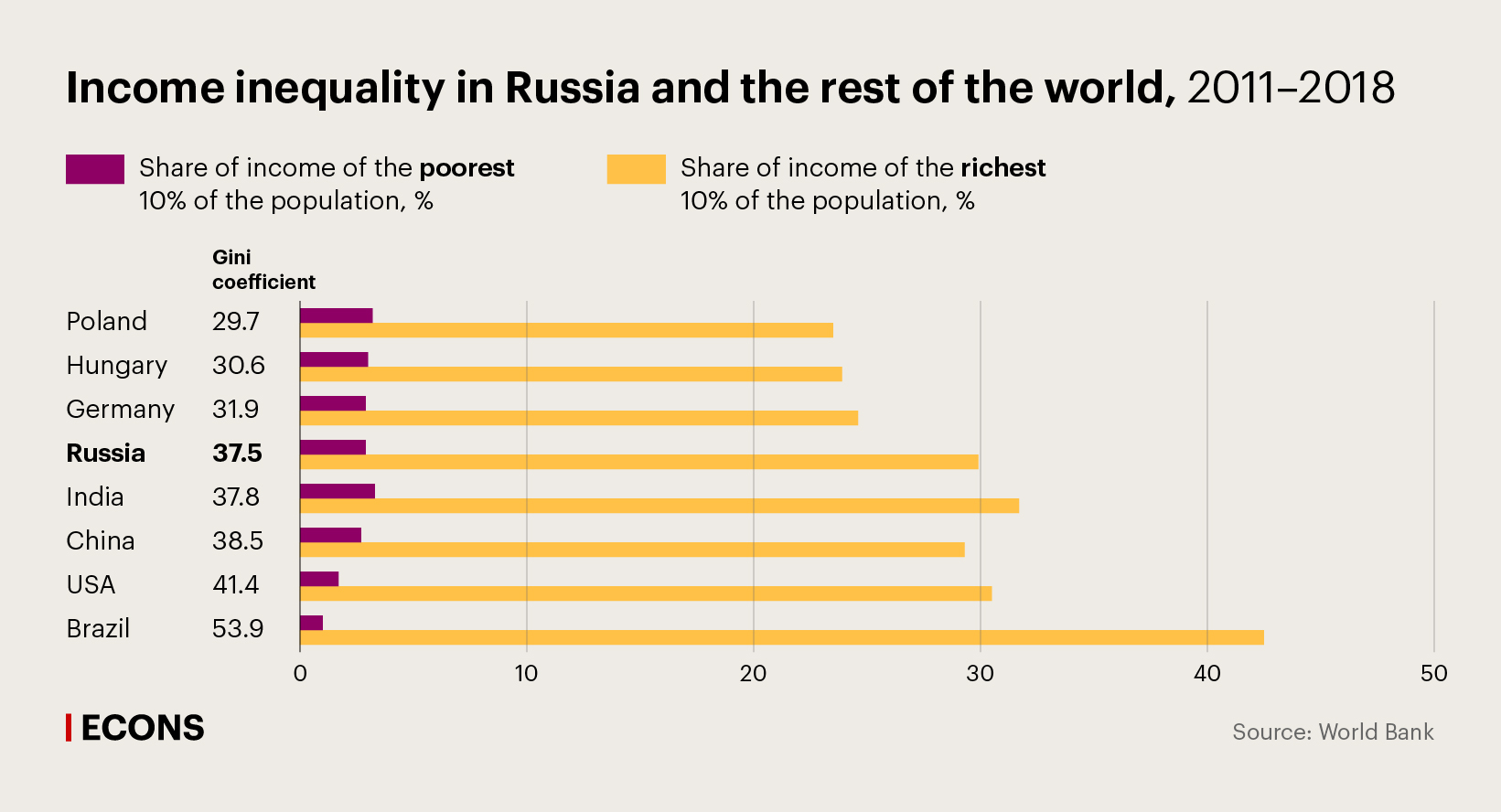

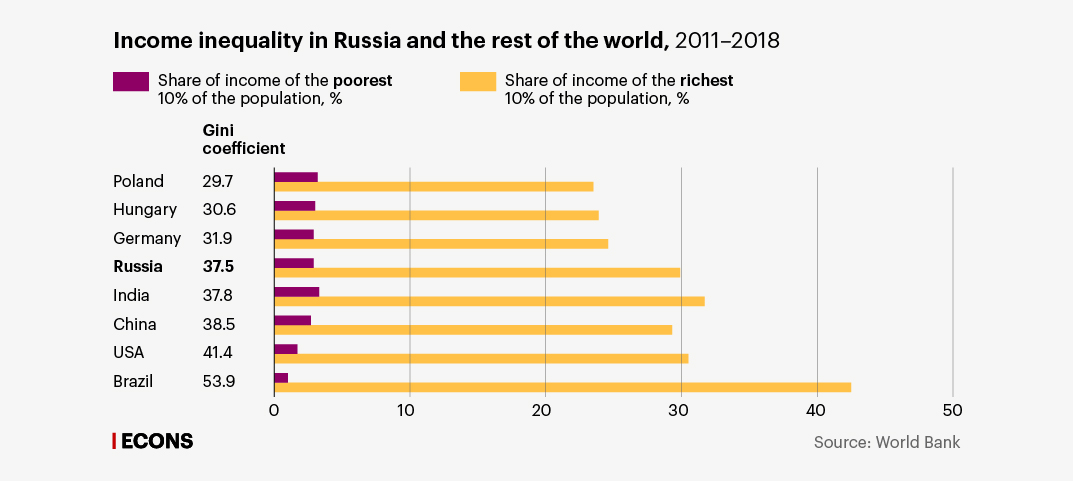
Measuring income inequality
The most common measure of income inequality is the Gini coefficient, where a 0 represents absolute equality and 100 absolute inequality. Analysing stratification, we also evaluate the shares of income accounted for by each quintile (dividing the population into five equally sized groups according to income) or decile (ten equally sized groups), particularly the top and bottom quintiles or deciles.
Equivalence scales are sometimes used when measuring income in order to account for economies of scale in consumption. Larger households are assumed to need lower income per capita than smaller ones to maintain a comparable standard of living, because they can save on household goods (appliances, furniture, housing). For instance, the data provided by the Luxembourg Income Survey, which applies a scale of equivalence, give a much more positive picture of the wide-scale inequality in Russia even compared to the European countries—in this case, the Gini coefficient for Russia is 31.8, compared to 29.6 in Germany and 38.4 in the United States.
It is worth noting, however, that the applicability of different equivalence scales to Russian conditions is a separate matter; for example, European equivalence scales may be irrelevant for Russia, where basic goods (e.g., food, clothing, shoes), which do not allow for economies of scale, account for a larger share of consumption.
Wide-scale inequality decreased in the 2000s, as the incomes of lower-income people grew faster than those of Russians in general. These tendencies transformed Russian society from a society of mass poverty to a society with dominant middle groups. And although their standard of living remains quite modest, it is still much higher than that of physical survival: as for recent years, we can talk about the large share of lower-income groups in Russia, but not about massive impoverishment.
However, throughout the 2000s, the ‘zone of prosperity’ narrowed: the middle-income share of the population (incomes 1.25–2 times higher than the median), as well as the share of the well-off (with incomes two or more time higher than the median), shrank, as members of these groups moved into the mass ‘median’ group. Finally, at the same time, there was a significant and never-shrinking gap between the top income groups (which make Russia a world leader in terms of income and wealth concentration) and the rest of the population.
Average and median income in Russia
According to Rosstat, in 2019, the average per capita income of Russians was 35,247 rubles per month ($545), the median average per capita income was 26,363 rubles per month ($407,5), and the minimum cost of living over the same period was 10,890 rubles ($168).
The impact of the current crisis on income inequality is yet to be analysed, but preliminary estimates show that the current crisis and the government’s response to it may have decreased inequality between the lower- and middle-income groups even more, without reducing the overall level of inequality in the country. In particular, a study conducted by World Bank economists and presented (article via link in Russian) at a seminar of the Institute for Social Policy of the Higher School of Economics indicates that the least prosperous have seen a relative gain of 40% and that the crisis has had a smaller impact on them, while the Gini coefficient for the population as a whole is expected to rise. This is largely the result of social support programmes targeting mainly families with several children, as well as retirees.
It may seem that these trends should have reduced social tensions since inequality is one of the most acute social problems in public opinion. In fact, the issue of inequality has not become less acute and is still a key ‘sore point’ for the country's current development.
All social groups, with no exception, consider the income inequality in Russia extremely large and utterly unfair, and there are no value differences between more and less prosperous groups in this respect.

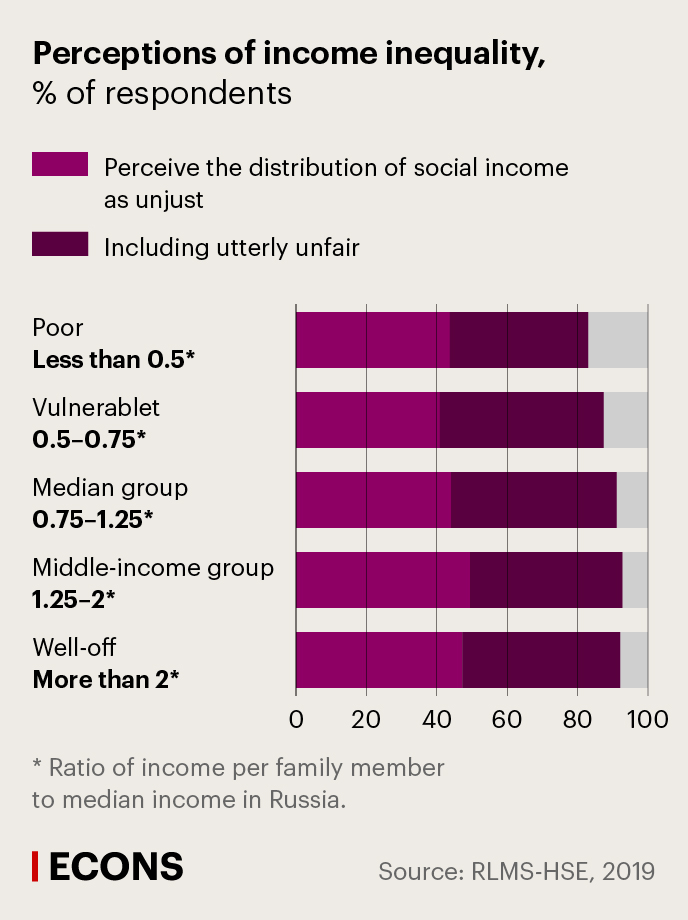

There are a number of reasons for this. The gap between the thin top income group and the rest of the population is growing, and it is this side of monetary inequality that society takes the hardest, rather than the inequality between larger groups of the population. Moreover, society perceives this gap between the wider population and the top income group as illegitimate. At the same time, the number of those better-off than the larger groups (with incomes of twice the median or more) is decreasing, which does not correspond to the needs of the most educated and qualified Russians. Finally, not only income inequality is perceived harshly, but also its various social dimensions.
Even the most educated and qualified Russians, with incomes no lower than the median and distinguished from the rest of the population by their objective position, see themselves as in the ‘middle’ and not as well-off. Therefore, when they talk about inequality, they mean the significant and growing gap between the thin top group and all other Russians, with whom they include themselves.
This is reflected in the way society (both in general and the well-off groups) perceives social conflicts in contemporary Russia, the key conflict being that between the rich and the poor. Unlike this acutely perceived confrontation between the numerous poor and the few rich, who seem to belong to a ‘special class’ confronting all other Russians, other conflicts, including traditional dimensions of class inequality (conflicts between the ‘bosses’ and ordinary workers or the working and middle classes) are much less pertinent for the population.
Since inequality is considered not only high but also unfair, recent years have seen growing demand for social homogeneity: a growing share of the population considers that the best social structure is one where there is little difference in income levels among people. Unfortunately, this also means that the potential role of inequality as a stimulus for individual activity and efficiency is diminishing. Russians have traditionally expected the state to reduce inequality, but they believe that the state is not effective in doing so, and in this the population is also unanimous.
At the same time, it is interesting that the leading principles of a fair society as perceived by the population are not connected with equal incomes but with alleviating key inequalities of opportunity: in healthcare, before the law, in access to the labour market and in the development of human capital, as shown by an all-Russian representative survey conducted in September 2020 by the Institute of Sociology of the Federal Center of Theoretical and Applied Sociology of the Russian Academy of Sciences (see the chart). The population does not believe that a fair society must have few rich people, but that the gap between the rich and the poor should not be the result of unfair inequalities of opportunity.
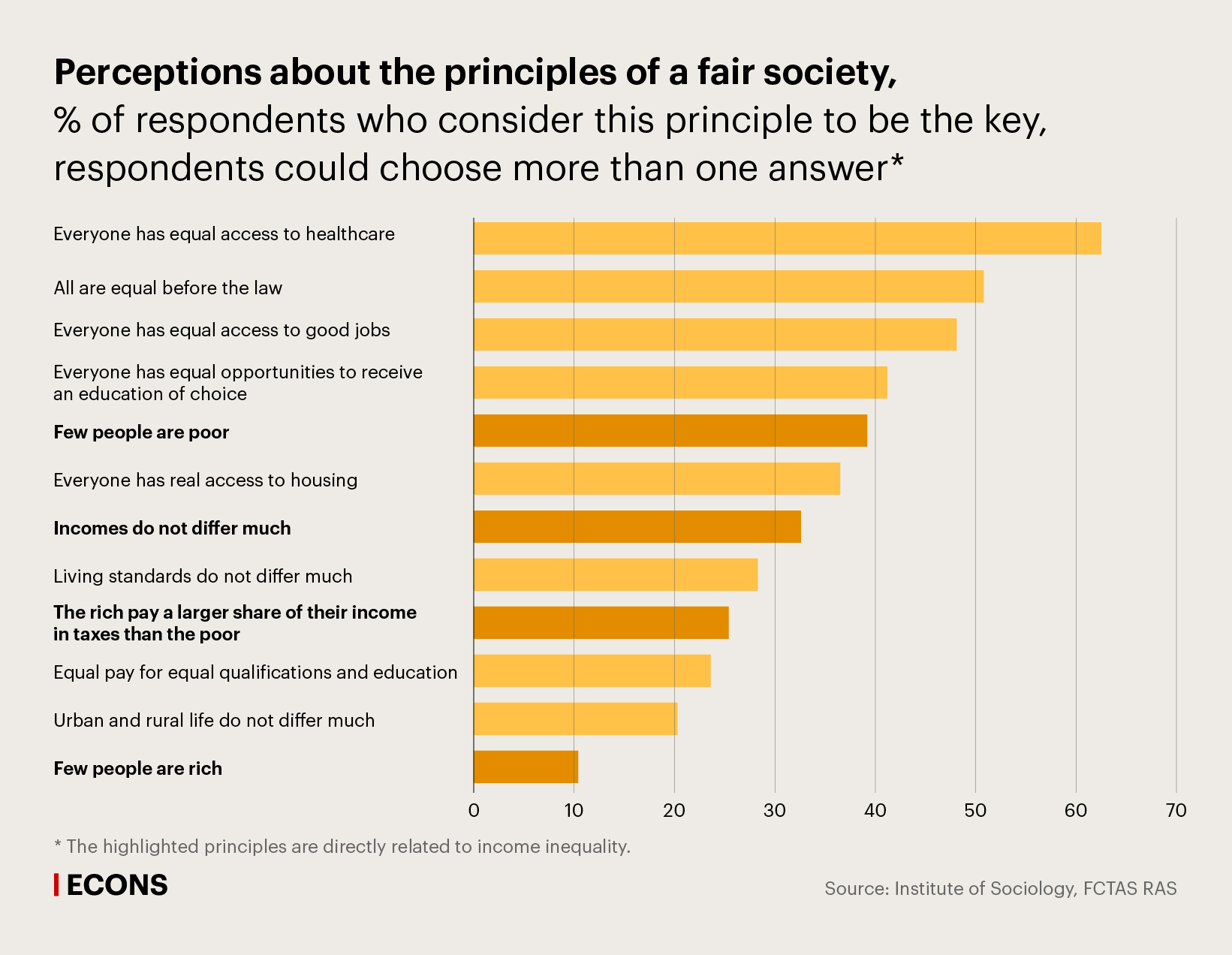

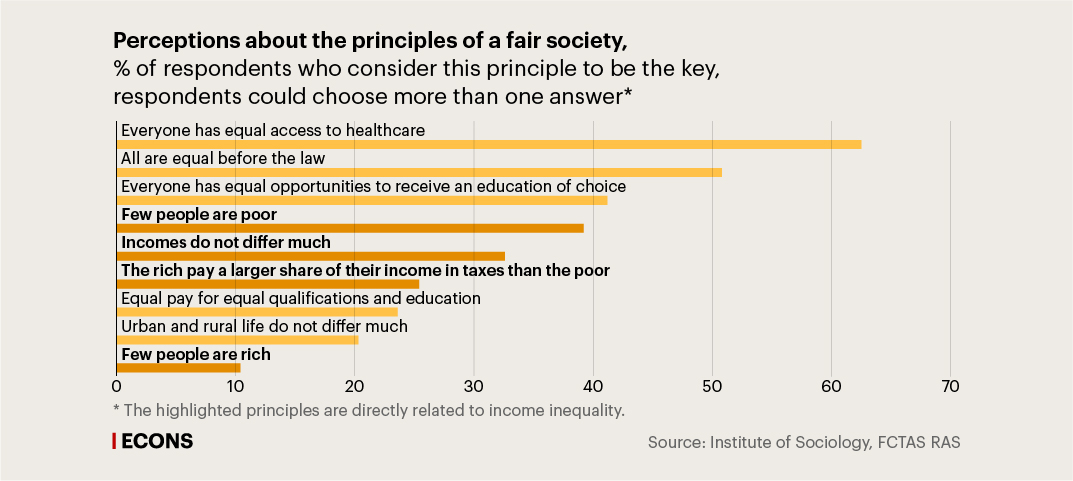
In this case, it is especially important to recognise the need for a new social contract between society and the authorities. This recognition is still missing among both the population and the elites. There are many questions to be answered when stating the provisions of this contract regarding inequality, and among them are questions of which methods are to be used to fight inequality and of which inequalities between which groups are to be eradicated: is it a matter only of supporting the poorest, of alleviating inequalities among the middle groups, or of reducing the gap between the top income group and the majority of Russians? The answers to these questions (or even the posing of them) are not yet on the social and political agenda, but without the answers, there can be no effective response to the serious challenge of inequality.
The situation is further complicated by the fact that the crisis caused by the pandemic has put additional emphasis on the importance of inequalities of opportunity, highlighting inequalities not only in access to healthcare, but also in employment conditions (sector of employment, type of enterprise, formal contract or informal employment) and ability to live in a digital environment (from working remotely to obtaining permits, necessary government services, ordering food, and using telemedicine), thereby exacerbating questions of social justice as well.







